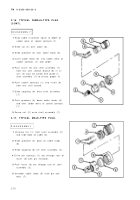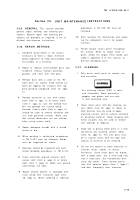TM-9-2350-238-20-2 - Page 118 of 495
WARNING
TM 9-2350-238-20- 2
2-31. TOUCHUP AND RECOATING .
• Chemical Agent Resistan t
Coating (CARC) Paint: CAR C
paint contains isocyanate, a
constituent that can caus e
respiratory effects during an d
after the application of th e
material. During the applicatio n
of CARC paint, coughing ,
shortness of breath, pain o n
respiration, increased sputum ,
and chest tightness may occur .
CARC paint also produces itch-
ing and reddening of the skin, a
burning sensation of the throa t
and nose, and watering of th e
eyes .
• An allergic reaction may occu r
after initial exposure (rangin g
from a few days to a fe w
months later), producin g
asthmatic symptoms includin g
coughing, wheezing, tightnes s
in the chest, or shortness o f
breath .
• The following precautions mus t
be observed to insure the safe-
ty of personnel when CAR C
paint is applied.
• For brush/roller painting in con-
fined spaces, an airline respir-
ator is required, unless an air
sampling shows exposure to b e
below standards. If the air
sampling is below standards ,
either chemical cartridge or
airline respirators are required .
• Spot painters applying CAR C
paint by brush or roller mus t
wear clothing and gloves af -
fording full coverage .
•
Do
not
use
water,
alcohol,
or
amine based solvents to thin or
remove CARC paints. Use o f
these solvents with CAR C
paints can produce chemica l
reactions resulting in nausea ,
disease, burns, or severe illness
to personnel .
•
Do
not
use
paint
solvents
to
remove paint/coating from you r
skin .
• Mix paint/coating in a well -
ventilated mixing room o r
spraying area away from ope n
flames. Personnel mixin g
paint/coating should wear ey e
protection .
• Use paint/coating with ade -
quate ventilation .
• Unusable CARC mixtures ma y
be considered hazardous wast e
and may require disposal IA W
Federal, state, DoD, and DA
hazardous waste regulations .
Consult the installation en-
vironmental office for prope r
disposal guidance. Mixed CAR C
has a flashpoint of approx-
imately 38° F (3° C) due to the
incorporation of solvents and is
highly flammable .
When touching up damaged areas, the pro -
cedure should be as similar to the origina l
method of finishing as possible; a clean sur-
face is imperative. Where general disintegra-
tion of the surface is evident, or the under
surface is corroded, the coating must b e
stripped clean from the part. Corrosion mus t
be removed or neutralized by mechanical or
chemical treatment, or both, and the surfac e
metal must be pretreated, primed, and the n
topcoated .
2-7 8
Back to Top




















